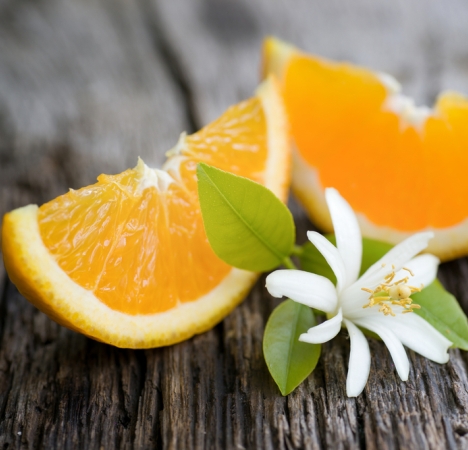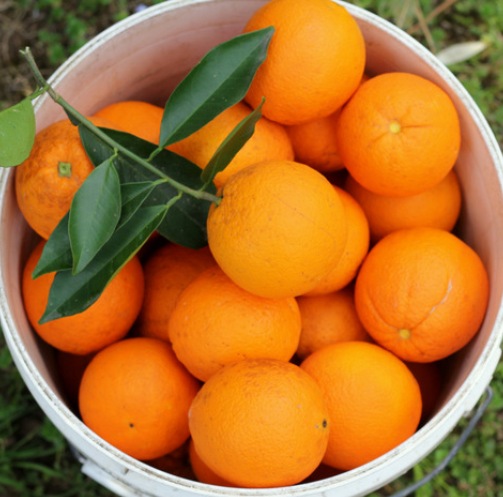-Essential-Oil.png)
-Essential-Oil.png)




Botanical name Citrus aurantium
Family Rutaceae
Source Fruit peel
Origin Italy
Processing Method Cold Pressed, then steam distilled
Color/Consistency A thin, yellow to brownish green liquid.
Aromatic Summary / Note / Strength of Aroma A top note with a medium aroma, Orange Essential Oil has a sweet, citrus smell like the orange peels from which it is derived, with some bitter notes similar to grapefruit.
Blend wit Clove Bud, Cinnamon Bark, Nutmeg, Sandalwood, Myrrh, Clary Sage, Lemon, Bergamot, Lavender.
Product Abstract
The Bitter Orange tree is an evergreen that grows up to 30 feet high with glossy dark green leaves and fragrant white flowers. The essential oil is produced by cold pressing of the peel. The bitter orange is really a native plant of the exotic regions within the Asian continent. Nowadays, the bitter orange is widely grown like a plantation tree through the entire tropics as well as subtropical areas of the world. Areas along the Mediterranean coast abound in orchards of the bitter orange; Spain particularly has numerous of those orchards.
History
The bitter orange is discovered and prepared like a scent throughout the 16th century, supposedly by an Italian princess named Anna-Marie de Nerola; she utilized the oil to scent her gloves. The usage of medicinal oranges is definitely the main domain of the Chinese herbalists, who’re still the best enthusiasts of medicinal oranges and its particular remedies today.
Harvesting/Extraction Information
This essential oil is obtained from the peels of orange by cold compression. Although most of you know the common name of oranges, you may not know the botanical name, Citrus sinensis. The liquid that comes in packets inside orange-flavored soft drink concentrate is sometimes composed of this oil. The main components of this oil are alpha-pinene, citronellal, geranial, sabinene, myrcene, limonene, linalool, and neral.
Common Usage
Caution
Orange essential oil displays photo-toxicity. It tastes bitter and if ingested in large quantities, it may result in vomiting, nausea, and loss of appetite.
Key constituents
(þ)-Limonene 90.4–97.7%
b-Myrcene 1.5–3.6%
Linalool 0.2–1.0%
Non-volatile compounds
Bergapten 0.039–0.078%
Epoxy-bergamottin 0.092%
Psoralen 0.005%
Quality May be adulterated with sweet orange oil, orange terpenes, and traces of character compounds (Burfield 2003).
Safety summary
Hazards Skin sensitization if oxidized; phototoxic (low risk).
Contraindications (dermal) If applied to the skin at over maximum use level, skin must not be exposed to sunlight or sunbed rays for 12 hours.
Cautions Old or oxidized oils should be avoided.
Maximum dermal use level 1.25% (for phototoxicity).
Our safety advice
Because of its (þ)-limonene content we recommend that oxidation of bitter orange oil is avoided by storage in a dark, airtight container in a refrigerator. The addition of an antioxidant to preparations containing it is recommended.
Regulatory guidelines
Has GRAS status. To avoid phototoxicity, IFRA recommends that, for application to areas of skin exposed to sunshine, bitter orange oil be limited to a maximum of 1.25% in products applied to the skin, except for bath preparations, soaps and other products which are washed off. This NOAEL was based on studies conducted with pooled samples of bitter orange oil in miniature swine and hairless mice, which showed a NOEL of 6.25% (IFRA 2009). IFRA also recommends that essential oils rich in limonene should only be used when the level of peroxides is kept to the lowest practical level, for instance by adding antioxidants at the time of production (IFRA 2009). In Europe, essential oils containing furanocoumarins must be used so that the total level of bergapten will not exceed: (a) 15 ppm in finished cosmetic products intended for application to skin areas likely to be exposed to sunshine, excluding rinseoff products; or (b) 1 ppm in sun protection and in bronzing products. In the presence of other phototoxic ingredients, the sum of their concentrations shall not exceed 100% (SCCNFP 2000).
Organ-specific effects
Adverse skin reactions Undiluted bitter orange oil was moderately irritating to rabbits and was very mildly irritating to mice; tested at 10% on 25 volunteers it was neither irritating nor sensitizing. In a study of 200 consecutive dermatitis patients, three (1.5%) were sensitive to 2% bitter orange oil on patch testing. In a clinical trial, bitter orange oil was applied to three groups of 20 patients each, at 20% in alcohol three times daily (group 1), at 25% in an emulsion three times daily, or 100% once daily for 1–3 weeks. The patients were being treated for superficial dermatophyte infections, one of the most common types of fungal skin conditions. There were no side effects, except for “mild irritation” in group three. A 65-year-old aromatherapist with multiple essential oil sensitivities reacted to 5%, but not 1% orange oil. Autoxidation products of (þ)-limonene can cause skin sensitization. Distinct phototoxic
effects were found for bitter orange oil.
Reproductive toxicity The low reproductive toxicity of (þ)- limonene suggests that bitter orange oil is not hazardous in pregnancy. Also, see sweetorange oil, below.
Systemic effects
Acute toxicity Non-toxic. Bitter orange oil acute oral LD50 in rats >5 g/kg; acute dermal LD50 in rabbits >10 g/kg.
Carcinogenic/anticarcinogenic potential Orange oil (type unspecified) was not mutagenic in the Ames test, and did not produce CA in Chinese hamster fibroblasts (Ishidate et al 1984). Orange oil (type unspecified) significantly
induced glutathione S-transferase in mouse liver and small bowel mucosa and inhibited B[a]P-induced neoplasia of both forestomach and lungs (Wattenberg et al 1985). Orange oil (type unspecified) demonstrated a chemopreventive action in both nitrosomethylurea-induced rat mammary carcinomas and N-nitrosodiethylamine-induced preneoplastic hepatic lesions in rats (Bodake et al 2002, Maltzman et al 1989). Orange oil (type unspecified) also inhibited NNK-induced pulmonary adenoma formation and the occurrence of forestomach tumors in mice (Wattenberg & Coccia 1991). (þ)- Limonene displays anticarcinogenic activity (see (þ)-Limonene profile).
Comments
Expressed sweet orange oil is not phototoxic. It might, therefore, be preferable for use in some instances. Some authorities believe that the bitter orange is a hybrid of C. reticulata and C. maxima.